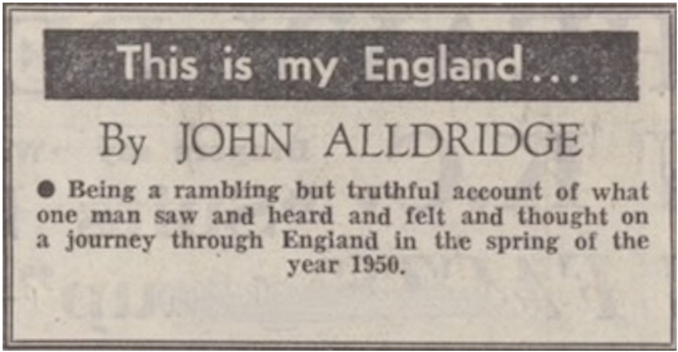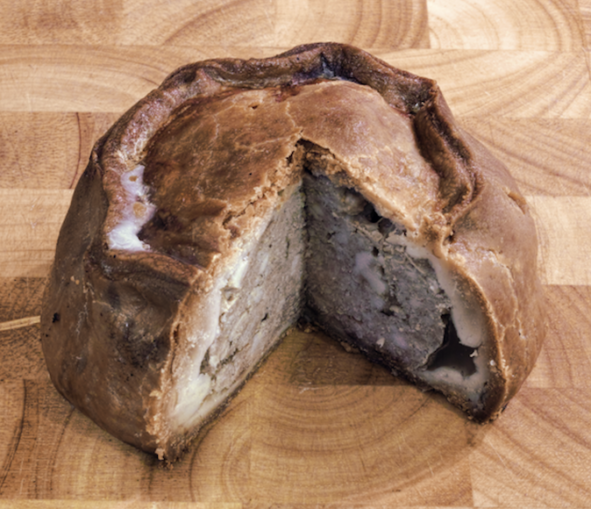
This Is My England,
© 2022 Newspapers.com
I was awakened that morning by the sudden furious ringing and clanging of bells — a sort of wild, insane music, as if some demented Dickensian sexton had been let loose in the belfry.
To me, groping my way, frantically back from sleep, it sounded like the end of the world. Then I remembered where I was. This was Loughborough, where, among a number of less interesting things, they make about a third of all the bells in England.
They have been making — or “founding,” to use the proper term — bells here in Loughborough for at least 300 years. In fact, this foundry, whose bell-tuning had so rudely awakened me, can trace its beginning back to 1360, when its master was Johannes de Stafford, one of the greatest bell-founders of all time.
With this great wealth of history behind it there ought, I felt, to be a mediaeval atmosphere about the place. You should at least have to announce your arrival by tolling a small, shrill-ringing bell at a wicket gate and be admitted through Gothic arches into a dim, cathedral light.
But this might be a boilermakers’ yard for all the glamour there is here. That is — until you realise, with something of a shock, that those small, tough little cranes are slinging about not boilers but bells.
I have never seen so many bells in all my life. There must have been hundreds of them. Big bells and little bells. Bells so big that their only conceivable use could be to toll the knell of dead kings and fallen empires. And bells so small — yet so impatient-looking — that when you heard them ringing you would instinctively glance at your watch to see just how late you really were.
There was one old bell there — it had come back for its first wash and brush up in 300 years — that had pealed a loyal welcome to Charles II on his restoration.
And there was a sturdy youngster, as high as my chin, who — if he passes his final exams today — will be sent off to ring in the next 500 years or so in a South African cathedral.
And not just an odd bell, sneaking back furtively to have his voice raised a harmonic or so, but whole families, or carillons, of bells.
One great family now nearing completion is being made for Kansas University. There will be fifty of them all told: ranging from the baby, a shrill little chap, weighing ten pounds or so and not much more than a foot high, right up to the head of the family himself, a giant of a bell seven feet tall and weighing every ounce of seven tons.
But even he isn’t the biggest bell here. There is one brazen monster standing out in the yard so enormous that a family of five could eat their Sunday dinner in comfort inside him.
His name is “Great George.” He weighs 15 tons, and one day, when they hang him up in Liverpool’s Anglican Cathedral, he will strike the lowest note of any bell in the British Empire — lower even than “Great Paul” in London, who was cast here in November, 1881.
Great George has been waiting out there in the yard since he was cast in 1937, when he was valued at £3,000 (today, so high have metal prices rocketed, you couldn’t buy him for a penny less than £9,000).
And it is somehow fitting that he should be out there in the middle of what is really a graveyard. For there, lying in heaps, are bells from half the blitzed churches in England.
They will never ring again, these bruised and broken messengers of peace and goodwill. But this is not the end for them. They will go back into the melting pot — bells from the vanished churches of London and Coventry and Plymouth — and be fashioned again and given voices as sweet and true as ever they were before.
One thing there is common to all these bells — they all look exactly alike, whether they are 500 years or only five minutes old. That is because in all the thousand years and more that bells have rung in England the way of making them has hardly changed at all.
Nowadays, it’s true, a bell can be given a voice far beyond the range of the mediaeval bell-makers, who cast their masterpieces in the very churchyard itself. (A bell may sound to you to have only one note, but in reality it has five: the Strike Note, the Nominal, an octave higher, the Hum, an octave lower, the Tierce, a minor third, and the Quint, a perfect fifth).
Imagine two huge thimbles — the outer of iron, the inner of brick — one fitting so close inside the other that there is just enough room for a molten mixture of pure copper and tin to find its way around, and you have a rough idea of how the shape of a bell is formed.
It is only a matter of minutes to cast a bell, but then it must stand sometimes for days — buried up to its neck in sand and slowly cooling all the time. Then, when the remains of its skin have been knocked away, it is swung across to the tuning room to be given a voice.
For hours at a time the tuner will work away at the inside of the bell with what looks like a pair of giant callipers. Slowly, a little at a time, he will cut away an infinitesimal flake of metal, afterwards testing the note of the bell against a tuning fork. (The old bell-makers used a bow drawn across a fiddle-string).
This is where you find your true artist among bellmen, for a well-tuned bell will ring true for centuries.
Another thing I noticed here was that, of the sixty men employed in this famous foundry, almost all were middle-aged, and many were grandfathers. I asked the obvious questions, knowing only too well what the answer would be.
“All a youngster wants today is a button to push and his pay packet regularly every Friday,” said the grizzled foundry foreman, who has hung his bells in most of the churches and cathedrals of the English-speaking world.
But I think, perhaps, he was being a little hard: for in his own tuning room I found one young man who was scraping away at the inside of a bell as if his life depended on it.
He told me that he had given up a well-paid job in the local engineering works because he didn’t seem to be making any progress there. Here, he said, hesitantly, you could see what you were doing; you were making something worthwhile.
I know what he meant. It’s an exciting thought that the bell he was tuning this morning will still be ringing when Kansas City is as old as Canterbury.
We heard Loughborough’s bells ringing us to bed that night. But that was in Cambridge and still many hours away. In the meantime we had to travel right across the green heart of England — and how green that heart can be on a fine May morning, when even the purple carpets in the bluebell woods seem more than a little sea green. Only a Shelley or a Browning could tell you properly.
Since I am neither, let’s hurry on over the rolling hills to Melton Mowbray (which is disappointing if you know it only through “Handley Cross”), where we shared a table and one of the famous pork pies (and how good they are, too, with some salad and a bit of Stilton!) with a pair of elderly, tweedy, huntin’ ladies who talked all the time in gloomy, satisfied whispers of broken collar-bones and vets and Bright’s disease and similar pleasantries.

A Melton Mowbray pork pie,
Innocenceisdeath – Licence CC BY-SA 3.0
We were setting a course south and east for Peterborough and Bury St. Edmunds. But at Stamford — it was sacked by the Lancastrians during the Wars of the Roses and looks as if it has never quite recovered — we saw something which made us abruptly alter course.
It was a roster stuck up on a church wall which advertised a trip that evening around the tulip fields of Spalding. We decided to take the hint. It meant going nearly 20 miles out of our way and missing Bury St. Edmunds altogether. But it was worth it.
It didn’t seem so at first.
A land of endless, ruler-straight dykes and canals, and pollard willows, which are surely the ugliest of all trees. A land of flat-faced, dull-looking farmhouses and an everlasting series of frustrating, time-wasting level crossings.
We had just reached the stage when we were in half a mind to turn back when suddenly, without warning, we saw them. From that distance they looked like some giant child’s paintbox — thousands and thousands of tulips, whole acres of them, divided up into neat squares of blazing colour: close up the paint-box illusion vanished and you saw it instead as a vast military tattoo, with squadrons and battalions and brigades of Scarlet Grenadiers and Royal Orange Hussars and Yellow Dragoons drawn up perpetually in ceremonial order.
But there was tragedy behind that fine show. The trippers who rushed from the motor coaches with eager “ohs” and “ahs” to fill their arms with the flowers already cut and waiting for them saw nothing of it.
I should have come away without learning about it myself had I not gone into the fields and talked to one of the women, a big, hearty, buxom soul, who was working among them.
It seems that a few days earlier, when these tulips were at their best, an hour of heavy rain followed a morning of blistering heat. In that one hour almost every full-grown flower in that field — and in every other field for miles around — was ruined.
Just a little discolouration here and there, a blister or two where the petals should be smooth and velvet, nothing that would have worried the keener amateur gardener.
And yet it meant disaster for the tulip farmer. Blooms that were fetching two shillings a dozen in Covent Garden only two days before were now only fit to feed cattle.
This is the seasonal gamble that every Lincolnshire farmer must be prepared to take whether he raises tulips or turnips. That he does take it every year — and having taken it will philosophically stand or fall by the outcome, be it fortune or flood — is one of the minor marvels of our race.
Reproduced with permission
© 2023 Newspapers.com
Jerry F 2023



